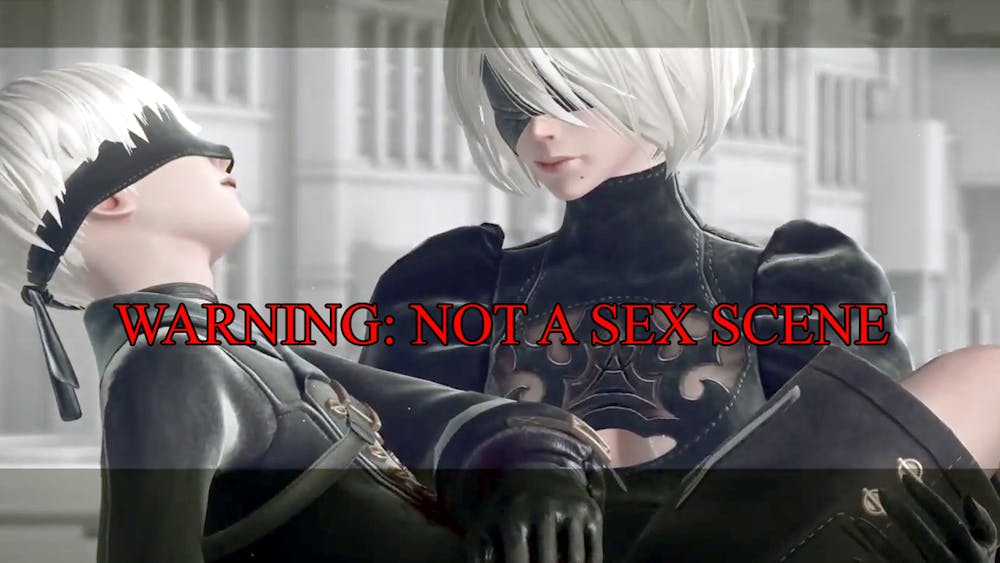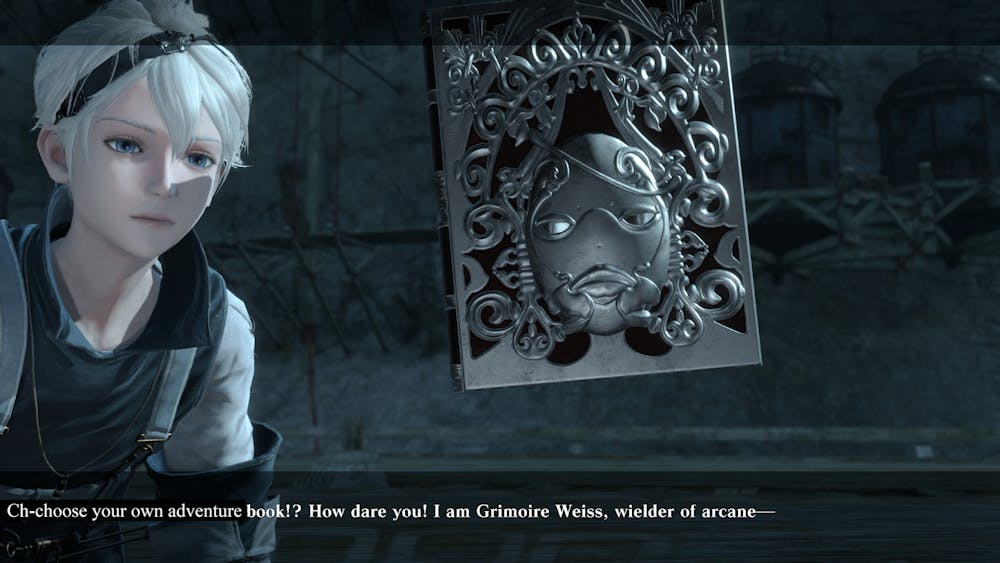How Nier Provides Deep Satisfaction for You (and Your Idiot Friends)

Posted June 17, 2021
by Brandon Garner
The remake of Nier: Replicant was released this Spring, which you probably heard about in some capacity from a friend who plays too many video games. Following a mention of the weird-ass name is a cacophony of aborted explanations on what the game even is: “You see, first you beat it, and then you beat it three more times, but uh, this time… you know what, let me start over. Sorry.” Twenty minutes later you’re desperately trying to change the conversation while your friend shamefully apologizes and tries to backtrack out of this hole they’ve dug, only to then deny that they even heard of the game themselves. “Uh, Nier? What is that? Haha, sports!” I’ve certainly never been in this experience myself. Uh, what experience? Haha, sports!
I’ll take a shot at describing the cult phenomenon of Nier without freaking out (again). It’s a series of modern games released within the last decade that uses hack-and-slash gameplay to completely subvert mechanical and story-telling conventions in ways never before seen in any medium. Also, the first one was released 10 years ago, then a sequel came out 7 years later, and then the first one was remade in April and should be played after the sequel – ok, nope, I’m freaking out again. See, not only do these games have a lot going on from a conceptual view, but they also are just weird. The artistic director, Yoko Taro, is both a genius and also kind of a lunatic who wears a mask in all of his interviews. That kind of person is going to leak their weird into their product.

For example, the first game was originally named Nier and then re-titled Nier Replicant ver.1.22474487139. You play as a young man living in a neo-medieval age 1,300 years after humanity has been mostly wiped out. In the process of saving your sister from a disease made of floating letters (yes, really), you befriend a woman who wears lingerie and swears like an insecure eighth grader, a young boy who becomes a flying skeleton, and a witty British man who has been turned into a floating magical book. Really. And that’s just the first game – the second one takes place 8,000 years later, starring an android dressed like a bondage-maid who fights in a proxy-war against robots made by aliens. And now we breathe, because that is a LOT to deal with. It may kick off your “Zach Snyder radar” indicating all-style-and-no-substance, but there’s good news! The writing, characters, environment, and various gameplay elements that range from hack-and-slash to shooter to text-based-adventure, are incredibly substantial on their own. It’s clear that Taro and his team truly understand the forms they’re dealing with and how to screw with them – it’s just that there’s also an off-putting amount of style to go with it.
Now you’re starting to see why so many people have issues describing this series. Take all of the above, and then add in the fact that it innovates on the conventions of gaming – a huge challenge in its own right since the medium is haunted by a misconception that it’s only for immature men and children. “Give me bang bangs and shootie shoots for my Pikachus, please! Whoa, did you say subvert? Excuse me while I report you to the secret video game police; you’ll recognize them from their red hats and mustaches.” It’s a bit difficult to say that a video game changed how you think about perspective, but that’s exactly what happens here.

To boil it down without ruining the experience for new players, each of these games is a moderately-sized fantasy or sci-fi narrative that clocks in at 12 to 20 hours in length depending on how you approach them. Throughout the process, the story teases out lots of different questions while answering very few of them, in an experience akin to many different B-movies, followed by credits that roll while you ask “But what about so-and-so?” Just before you turn the game off and get annoyed at your friend for suggesting it, a notification appears: “Play a second time to get new information.” That’s right, you have to play it again. You do so apprehensively and with a bit of frustration, but within moments it becomes clear that things hit different this time: in one game you literally play as another character, and in another you are suddenly hit with a text-adventure that explains a character’s backstory. These aspects weren’t present before, and you’re clearly only scratching the surface of the proverbial glacier. And while this experience in itself is clearly an extremely interesting approach to retelling a story without it growing stale, it still gives an irk to your chest at the amount of work the game asks – no, demands – of you to get there. To get the full experience, you have to beat the game and to have enjoyed it just enough to want to do so all over again. It’s reminiscent of something that has been an issue with video games for most of their incarnation: gate-keeping.
I’m not referring to the incel-special of “name three songs that the band on your shirt plays” gate-keeping, but rather the nature of how video games function. The dialogue on this has existed for years, with the most succinct example being comedian Dara Ó Briain’s excellent bit about it on Live at the Apollo. The general idea is that video games require the player to pass a certain skill threshold in order to be granted permission to see the rest of the game. No other medium does this – as Ó Briain says, no book shuts itself at chapter 3 and asks you about the major themes. But video games do exactly that! The conversation these days generally revolves around whether games should allow everyone to be able to enjoy every part of a game no matter the individual, including various accessibility requirements, while also providing a rewarding experience that delivers a level of challenge to those who want it. Obviously, this is the easiest problem to solve that has ever existed and we’re done here. End of essay!
What I just described, the idea of trying to provide challenge but not discouragement, is a nightmare scenario for game developers. Many games today take different approaches to this: there's the optional-but-more-fun stages of Mario, the added accessibility and difficulty options of The Last of Us 2, the completely modifiable difficulty structure of Kingdom Hearts 3 — then there’s Dark Souls, which ignores the conversation and effectively says “This is hard and isn’t for everyone. Goodbye. Or Hello. Whatever. Are you still here?” I am clearly not the person to provide the answer to this issue, but I think it may lie in the fact that there are so many different approaches to the solution; there may be no one-size-fits-all answer. So what do we make of Nier, a series that keeps you from experiencing it without getting to the end multiple times like a Choose Your Own Adventure book from hell? Personally, I think it’s pivotal to the discussion.

While Nier’s replay idea may sound bad or absurd at first, I think blocking its truly interesting story from people who don’t want to play again is an amazing approach to appealing to the spectrum of players’ needs. Think of all the movies and books that screw with form. Remember how many people absolutely HATED them? The day I’m Thinking of Ending Things dropped on Netflix, or after Lincoln in the Bardo ended up on Bestseller lists, my feeds lit up with people who thought that their time had been wasted, which makes complete sense! Not everyone is here to explore experimental media forms! Many just want to have a good time, a need that is incredibly real which I don’t want to diminish in any way.
Now imagine a scenario where you and your friend watch the same movie. The movie’s interesting - it has good characters, a solid premise, and real propulsion. Eventually, the story completely halts to indicate an ending, but it feels incomplete to you, as there are still unresolved threads. But your friend doesn’t think so. In fact, not only does said friend think that everything is all wrapped up, but they then walk away feeling completely satisfied. “That was great!” they say as you silently stew in your seat. You would normally get up to join them and disagree about the film’s quality, but not this time! Instead, the movie suddenly picks up where it left off, giving you the chance to witness fully resolved emotional arcs that provide you with the same satisfaction your friend feels.
While what I just described is only a rug-pull and oversimplifies Nier, the scenario’s implications are still tremendous: both you and your friend can be fulfilled from the same piece of art while being fully convinced that you each experienced everything it had to offer despite having completely different needs. That’s what Nier does. In your first playthrough of both games, you’re taught to become comfortable with the protagonist’s development and character arc, which is fine on its own, covering the standard fare of found-family, duty, and pride. That’s enough for many. But if you take the plunge, the additional narratives and various mechanics will teach you ideas that are much more profound: that life is truly satisfying when you strive to understand others’ perspectives, and that anyone can learn to put others’ needs before themselves - they just need to be shown the path.
These emotional experiences and the unique ways they’re implemented have stayed with me for years. Even when I forget some of the details, the impact stays with me in a way that is truly touching and can only be accomplished through video games. That’s why your friend stumbles in their explanation of the game - they’re finding new words to describe new feelings. And that’s why people make things, isn’t it?
If you feel like any of what I’ve described here connected with you and that it might be up your alley, then you need to go play the Nier games immediately. Make sure you begin with Nier: Automata, as the games are separate enough that no prior knowledge is required, and the developers only really perfected their methods in that iteration. Then move on to Nier: Replicant, which is a bit rougher around the edges, but has had new things added to it for a remake, effectively making it both a narrative prequel AND an emotional sequel to Automata. Weird? Yes. But that’s Nier.
